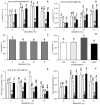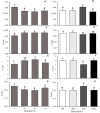How does shading mitigates the water deficit in young Hymenaea courbaril L. plants?
- PMID: 37794932
- PMCID: PMC10546060
- DOI: 10.3389/fpls.2023.1235234
How does shading mitigates the water deficit in young Hymenaea courbaril L. plants?
Abstract
Information on tolerance to isolated or combined abiotic stresses is still scarce for tree species, although such stresses are normal in nature. The interactive effect of light availability and water stress has been reported for some native tree species in Brazil but has not been widely investigated. To test the hypothesis that shading can mitigate the stressful effect of water deficit on the photosynthetic and antioxidant metabolism and on the growth of young Hymenaea courbaril L. plants, we evaluated the following two water regimes: a) continuous irrigation - control (I) - 75% field capacity. and b) water deficit (S), characterized by irrigation suspension associated the two following periods of evaluation: P0 - when the photosynthetic rate of plants subjected to irrigation suspension reached values close to zero, with the seedlings being re-irrigated at that moment, and REC - when the photosynthetic rate of the re-irrigated plants of each shading levels reached values similar to those of plants in the control treatment, totaling four treatments: IP0, SP0, IREC, and SREC. The plants of these four treatments were cultivated under the four following shading levels: 0, 30, 50, and 70%, constituting 16 treatments. Intermediate shading of 30 and 50% mitigates the water deficit and accelerates the recovery of H. courbaril. Water deficit associated with cultivation without shading (0%) should not be adopted in the cultivation or transplantation of H. courbaril. After the resumption of irrigation in the REC, the other characteristics presented a recovery under all cultivation conditions. Key message: Intermediate shading of 30 and 50% mitigates the water deficit and accelerates the recovery of H. courbaril.
Keywords: antioxidant enzymes; chlorophyll a fluorescence; photosynthesis; proline; stresses abiotic.
Copyright © 2023 Reis, Scalon, Foresti, Dresch, Santos and Lima.
Conflict of interest statement
The authors declare that the research was conducted in the absence of any commercial or financial relationships that could be construed as a potential conflict of interest.
Figures






References
-
- Araújo L. F. B., Scalon S. P. Q., Dresch D. M., Junglos M. S., Mussury R. M., Junglos F. S. (2020). Water deficit alters morpho-anatomical and antioxidant responses in seedlings of CampOmanesia xanthocarpa enabling their recovery. Int. J. Agric. Biol. 24, 1431–1438. doi: 10.17957/IJAB/15.1580 - DOI
-
- Barbosa L. O., Dresch D. M., Scalon L. Q., Scalon S. P. Q. (2021). Ecophysiological Strategies of Cedrela fissilis Vell. Seedlings under Conditions of Flooding and Light Availability. J. Sustain For. 41, 783–798. doi: 10.1080/10549811.2020.1867183 - DOI
-
- Bartieres E. M. M., Scalon S. P., Dresch D. M., Cardoso E. A., Jesus M. V., Pereira Z. V. (2020). Shading as a means of mitigating water deficit in seedlings of CampOmanesia xanthocarpa (Mart.) O. Berg. Not Bot. Agrobot. 48, 234–244. doi: 10.15835/nbha48111720 - DOI
-
- Bates L. S., Waldren R. P., Teare I. D. (1973). Rapid determination of free proline for water stress studies. Plant Soil 39, 205–207. doi: 10.1007/BF00018060 - DOI
LinkOut - more resources
Full Text Sources

